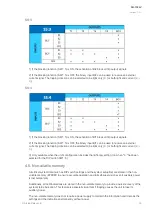
8. Testing
It is recommended that the unit is tested prior to substation energizing. Testing is carried out by
simulating an arc light for each sensor and verifying that the unit tripped and that the correct indicator
LED turned on.
A high-quality camera flash (Canon Speedlite 430EX or equivalent) is used to simulate arc light. You
can use a flashlight (Mini Maglite 2 CELL AAA or equivalent) to test non-latched signals and the CBFP
function. Before testing please check that the equipment used has a fully charged battery.
8.1. Testing the light-only mode
1. Check that the DIP switch settings are positioned according to your application.
2. Activate the camera flash within 30 cm (12 inches) of the sensor that is being tested.
3. Verify that the indicator LED of the corresponding sensor channel is lit.
4. Verify the activation(s) of the relay output(s) by checking the circuit breaker's status, or by
monitoring the trip contact's status. The circuit breaker should open, or the contacts operate.
Please note that you achieve the best test results when you operate the circuit breaker while
testing.
5. Verify that the indicator LED(s) of the corresponding relay output(s) is lit.
6. If you are using the BO1 binary output, verify its signal activation either through the status
change of the relevant input, or by measuring the signal output voltage. Please note that BO1
is of the non-latched type.
7. If you are using the BO1 binary output, also verify that the "BO1" LED is lit.
8. Press the SET
SET push button to reset all indications and latches.
9. If you are using the BI2 binary input as the master trip, activate it and verify that the trip has
occurred by repeating the steps 4 and 5.
10. Press the SET
SET push button to reset all indications and latches.
11. Repeat the steps 1 through 10 for all sensors.
8.2. Testing the light and current mode
1. Check that the DIP switch settings are positioned according to your application.
2. Activate the following two things simultaneously: the camera flash within 30 cm (12 inches) of
the sensor unit that is being tested, and the BI1 binary input used for the overcurrent
condition (I>).
3. Verify that the indicator LED of the corresponding sensor channel is lit.
4. Verify that the indicator LED of the BI1 binary input is lit.
5. Verify the activation(s) of the relay output(s) by checking the circuit breaker's status, or by
monitoring the trip contact's status. The circuit breaker should open, or the contacts operate.
Please note that you achieve the best test results when you operate the circuit breaker while
testing.
6. Verify that the indicator LED(s) of the corresponding relay output(s) is lit.
7. If you are using the BO1 binary output, verify its signal activation either through the status
change of the relevant input, or by measuring the signal output voltage. Please note that BO1
is of the non-latched type.
8. If you are using the BO1 binary output, also verify that the "BO1" LED is lit.
9. If you are using the BO2 binary input, verify its correct operations by activating the input.
10. Activate the camera flash within 30 cm (12 inches) of the sensor unit but do not activate the
binary input used for the overcurrent condition (I>).
11. Verify that no trip has occured and only the indicator LED of the sensor activation is lit.
12. If you are using the BOUT signal and have configured it to send light information, verify that it
is activated.
13. Press the SET
SET push button to reset all indications and latches.
A
AQ
Q-102L
-102LV
V
Version: 1.00
© Arcteq Relays Ltd
28
Summary of Contents for AQ-102LV
Page 1: ...AQ 102LV Arc flash protection unit ...
Page 24: ...7 Connections A AQ Q 102L 102LV V Version 1 00 23 Arcteq Relays Ltd ...
Page 25: ...Figure 7 10 Rear terminals of AQ 102LV A AQ Q 102L 102LV V Version 1 00 Arcteq Relays Ltd 24 ...
Page 26: ...A AQ Q 102L 102LV V Version 1 00 25 Arcteq Relays Ltd ...
Page 31: ...A AQ Q 102L 102LV V Version 1 00 Arcteq Relays Ltd 30 ...









































